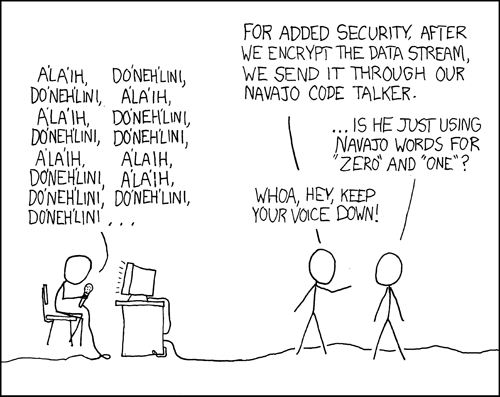| Natural Language as a Code |
| Written by Mike James |
| Sunday, 26 February 2012 |
|
This week's selected xkcd cartoon should be a real shocker in this day and age. Is it being suggested that a natural language, Navajo, and one that is spoken by a fairly large group of people, can be used as a code? What's happened to Google or Bing translate?
Yet it is all true. According to the website of the Navajo Code Talkers IT IS THE ONLY UNBROKEN CODE in modern military history. It baffled the Japanese forces of WWII. It was even indecipherable to a Navajo soldier taken prisoner and tortured on Bataan. In fact, during test evaluations, Marine cryptologists said they couldn't even transcribe the language, much less decode it. Back in the 1940 not only was there no automatic translation, but global communications were so poor that you could rely on the fact that if found a native speaker of a local language and transported them to another part of the world then, yes, their language could be and was used as a code. In World War II, Navajo was used as a means of secure radio communication. If you want a fictionalized account there's the movie Windtalkers, or there is a documentary from the History channel - see the sidebar. As well as Navajo, Comanche and Basque were used in the second World War and Cherokee was used in the World War I. The fact that the idea had already been used in the first world war was very nearly its undoing in the second. Hitler knew about the use of Comanche in WW1 and before WW2 sent a group of anthropologists to study Native American languages.
More cartoon fun at xkcd a webcomic of romance,sarcasm, math, and language
The reason Navajo was selected for use in WW2 was partly that it had a complex grammar and was difficult to learn and at the time there was no written form. But the really important fact was that there were known to be very few non-Navajo speakers. As a result, spoken Navajo was very difficult for the opposition to crack as a code. To make it even more difficult, a set of code words for the alphabet and common miltary terms were used and the table was kept secret. In a sense the Navajo speakers were being treated as encryption/decryption keys and, as long as they were kept secure, then the code was secure. So the strange truth is that natural languages have been used as codes in the recent past, but it couldn't happen today without being very vulnerable to cracking simply by identifying the language and using a translation program. The use of a natural language is yet another example of trying to implement security by obscurity - which is generally a bad idea. At best obscurity can be used to slow down an attack, but it never provides the level of security that you might think. A good cryptographic system should be difficult to break, even when you have full knowledge of how it works. More InformationRelated ArticlesSecurity by obscurity - a new theory
Comments
or email your comment to: comments@i-programmer.info
To be informed about new articles on I Programmer, subscribe to the RSS feed, follow us on Google+, Twitter, Linkedin or Facebook or sign up for our weekly newsletter.
<ASIN:B00005JK8K> <ASIN:B000CSTK74> |
| Last Updated ( Sunday, 26 February 2012 ) |


